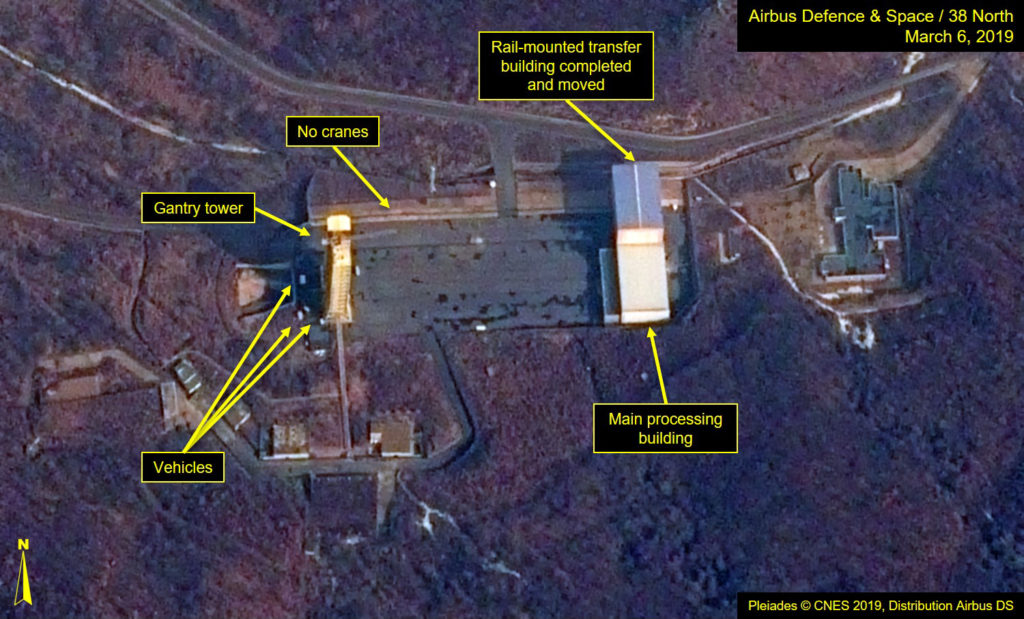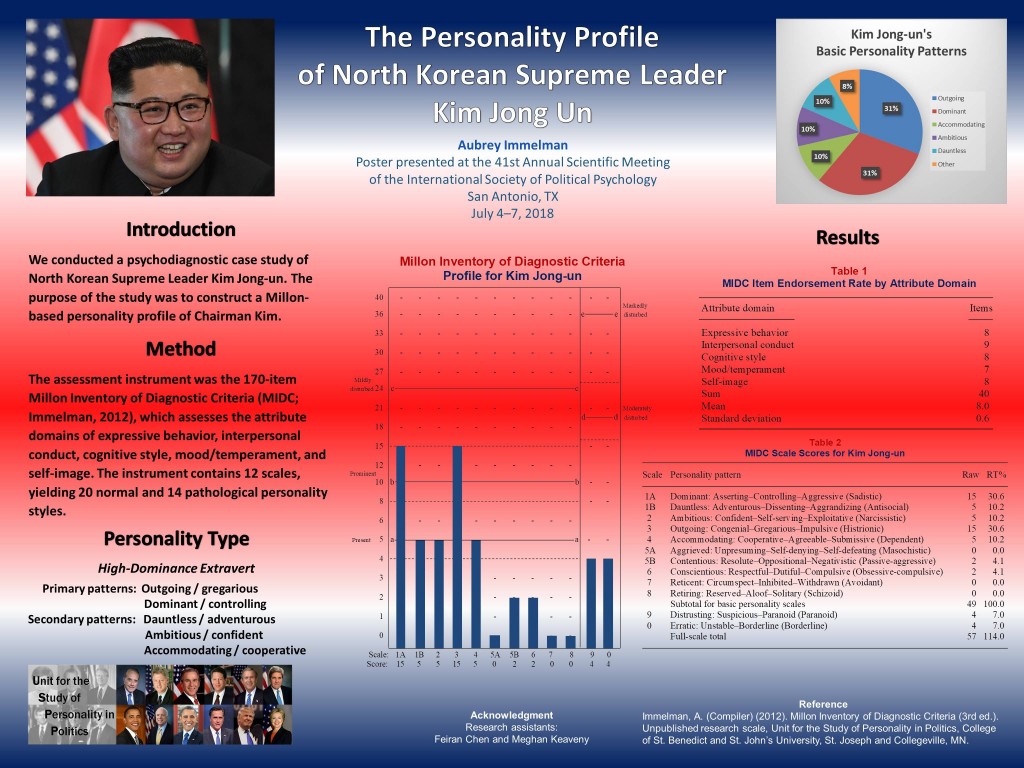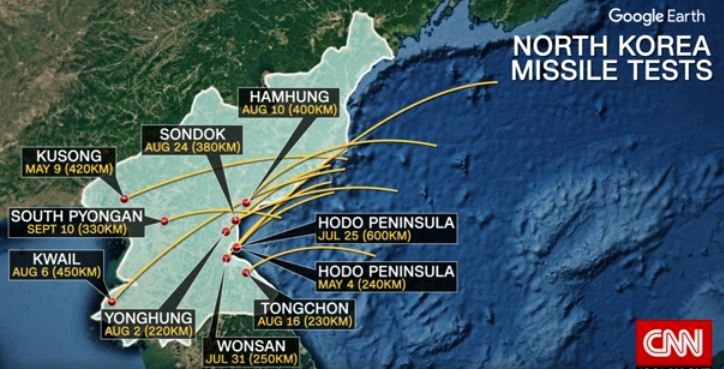Featured Posts

- Index of Psychological Studies of Presidents and Other Leaders Conducted at the Unit for the Study of Personality in Politics
- The Personality Profile of U.S. Supreme Court Associate Justice Brett Kavanaugh
- The Leadership Style of North Korean Leader Kim Jong-un
- North Korea Threat Assessment: The Psychological Profile of Kim Jong-un
- Russia Threat Assessment: Psychological Profile of Vladimir Putin
- The Personality Profile of 2016 Republican Presidential Candidate Donald Trump
- Donald Trump's Narcissism Is Not the Main Issue
- New Website on the Psychology of Politics
- Unit for the Study of Personality in Politics --- 'Media Tipsheet'
categories

- Afghanistan (228)
- Al Gore (2)
- Amy Klobuchar (4)
- Ayman al-Zawahiri (7)
- Barack Obama (60)
- Ben Carson (2)
- Bernie Sanders (7)
- Beto O'Rourke (3)
- Bill Clinton (4)
- Bob Dole (2)
- Campaign log (109)
- Chris Christie (2)
- Chuck Hagel (7)
- Criminal profiles (8)
- Dick Cheney (11)
- Domestic resistance movements (21)
- Donald Trump (31)
- Economy (33)
- Elizabeth Warren (4)
- Environment (24)
- George H. W. Bush (1)
- George W. Bush (21)
- Hillary Clinton (9)
- Immigration (39)
- Iran (43)
- Iraq (258)
- Jeb Bush (3)
- Joe Biden (13)
- John Edwards (2)
- John Kasich (2)
- John Kerry (1)
- John McCain (7)
- Kamala Harris (5)
- Kim Jong-il (3)
- Kim Jong-un (11)
- Law enforcement (25)
- Libya (18)
- Mahmoud Ahmadinejad (6)
- Marco Rubio (2)
- Michael Bloomberg (1)
- Michele Bachmann (173)
- Mike Pence (3)
- Military casualties (234)
- Missing person cases (37)
- Mitt Romney (13)
- Muqtada al-Sadr (10)
- Muslim Brotherhood (6)
- National security (16)
- Nelson Mandela (4)
- News (5)
- North Korea (36)
- Osama bin Laden (19)
- Pakistan (49)
- Personal log (25)
- Pete Buttigieg (4)
- Presidential candidates (19)
- Religious persecution (11)
- Rick Perry (3)
- Rick Santorum (2)
- Robert Mugabe (2)
- Rudy Giuliani (4)
- Russia (7)
- Sarah Palin (7)
- Scott Walker (2)
- Somalia (20)
- Supreme Court (4)
- Syria (5)
- Ted Cruz (4)
- Terrorism (65)
- Tim Pawlenty (8)
- Tom Horner (14)
- Tributes (40)
- Uncategorized (50)
- Vladimir Putin (4)
- Xi Jinping (2)
- Yemen (24)
Links

archives

- November 2021
- January 2021
- November 2020
- October 2020
- September 2020
- August 2020
- July 2020
- April 2020
- March 2020
- February 2020
- January 2020
- December 2019
- October 2019
- July 2019
- May 2019
- April 2019
- March 2019
- February 2019
- January 2019
- December 2018
- September 2018
- August 2018
- July 2018
- June 2018
- April 2018
- March 2018
- February 2018
- January 2018
- August 2017
- July 2017
- June 2017
- May 2017
- April 2017
- February 2017
- January 2017
- December 2016
- November 2016
- October 2016
- September 2016
- August 2016
- July 2016
- June 2016
- May 2016
- April 2016
- March 2016
- February 2016
- January 2016
- December 2015
- November 2015
- October 2015
- September 2015
- August 2015
- July 2015
- June 2015
- May 2015
- April 2015
- March 2015
- February 2015
- January 2015
- December 2014
- November 2014
- October 2014
- September 2014
- August 2014
- July 2014
- June 2014
- May 2014
- April 2014
- March 2014
- February 2014
- January 2014
- December 2013
- November 2013
- October 2013
- September 2013
- August 2013
- July 2013
- June 2013
- May 2013
- April 2013
- March 2013
- February 2013
- January 2013
- December 2012
- November 2012
- October 2012
- September 2012
- August 2012
- July 2012
- June 2012
- May 2012
- April 2012
- March 2012
- February 2012
- January 2012
- December 2011
- November 2011
- October 2011
- September 2011
- August 2011
- July 2011
- June 2011
- May 2011
- April 2011
- March 2011
- February 2011
- January 2011
- December 2010
- November 2010
- October 2010
- September 2010
- August 2010
- July 2010
- June 2010
- May 2010
- April 2010
- March 2010
- February 2010
- January 2010
- December 2009
- November 2009
- October 2009
- September 2009
- August 2009
- July 2009
- June 2009
- May 2009
- April 2009
- March 2009
- February 2009
- January 2009
- December 2008
- November 2008
- October 2008
- September 2008
- August 2008
- July 2008
meta

As reported in the New York Times (March 8, 2019), the collapse of the Feb. 27-28 Hanoi summit meeting with U.S. President Donald Trump “was considered a big embarrassment†for North Korean leader Kim Jong-un “because he had to return home empty-handed after Mr. Trump rejected his demand for relief from United Nations sanctions.â€
Satellite imagery indicating North Korea has begun to rebuild the Sohae Satellite Launching Station at Tongchang-ri has raised fears among some analysts that the country might resume missile tests (New York Times, March 5, 2019).

Sohae Satellite Launching Station, March 6, 2019 (Credit: Pleiades © CNES 2019, Distribution Airbus Defence & Space via 38 North)
The U.S. response to these developments is critical to the progress of denuclearization talks with North Korea. In that regard, it is noteworthy that DPRK state media adopted a conciliatory tone, expressing the hope that “the whole world sincerely hopes that the peace process on the Korean Peninsula will proceed smoothly and the North Korea-United States relations will improve soon†(Rodong Sinmun, March 8, 2019).
The New York Times notes that the DPRK “has shied away from using harsh language against the United States or Mr. Trump†and that by “only indirectly blaming Washington for the failure and voicing hopes for better ties,†the Rodong Sinmun commentary “appeared to signal a willingness to keep diplomacy alive with the United States.â€
That perspective suggests a path forward for the U.S., considering the political psychology of Kim Jong-un:
Chairman Kim is cooperative, willing to compromise or make concessions to resolve differences; however, he is also confident, competitive, and assertive and expects others to recognize his capabilities. As a dominant, controlling leader, he demands respect and can be tough and unsentimental in asserting himself. Finally, as an outgoing, expressive personality, he is not averse to employing dramatic, attention‑getting maneuvers to signal intent or to achieve his political objectives.
Thus, for President Trump, this is not the time to employ coercive diplomacy by reverting to “maximum pressure,†personal affronts to Chairman Kim’s dignity, or otherwise signaling hostile intent. Instead, the president should stay the course by continuing to emphasize his special relationship with Kim to accommodate his need for self-validation and permit him to save face as his nation’s supreme leader in the aftermath of the failed Hanoi summit.
In response to signals from North Korea on the resumption of rocket testing and satellite- or missile launches, there are three political-psychological inflection points for targeting resistance and gaining compliance:
- President Trump should guard against manipulative behavior by the DPRK designed to secure short-term payoffs.
- President Trump should be aware of and preempt Chairman Kim’s predisposition to terminate the negotiation partnership upon
realizing the structural constraints on the ability of the president to make concessions or offer assistance. - President Trump should deescalate the situation by reaffirming the strength of the negotiation partnership.
——————————————
March 14, 2019 Update
North Korea’s Sohae Satellite Launch Facility: No new activity since March 8 (Jack Liu, Peter Makowsky, and Jenny Town, 38 North, March 13, 2019) — Recent commercial satellite imagery of the Sohae Satellite Launching Station (Tongchang-ri) shows no changes to the launch pad or engine test stand between March 8 and March 13. … Full report
——————————————
March 16, 2019 Update
The U.S. and North Korea are back to talking tough (Uri Friedman, The Atlantic, March 16, 2019) — The attack dogs have been let loose. That much was clear from the stark message North Korea delivered this week after the collapse of Donald Trump’s summit with Kim Jong Un in Vietnam last month: Kim is considering abandoning nuclear negotiations with the United States and resuming the nuclear and missile tests that brought the two countries to the brink of war early on in the Trump administration. … The unmuzzling of the attack dogs on each side is a reminder that Trump and Kim are each contending with a hard-line faction at home that views the diplomacy they’re engaged in as a hopeless and dangerous endeavor. As [North Korea’s vice foreign minister, Choe Son Hui] noted this week, Kim decided to press ahead with diplomacy in Vietnam despite the fact that military leaders are petitioning him not to give up his nuclear program. … Full report
——————————————
March 22, 2019 Update

FOREIGN POLICY BY TWEET

President Donald Trump’s early afternoon tweet sent the international community scrambling.
Trump tweeted the administration would withdraw additional sanctions against North Korea … even though those additional sanctions had just been announced by his own administration.
The White House declined to give details on the sudden policy shift, but said Trump was pulling back newly issued sanctions because he “likes” North Korea’s leader Kim Jong Un, according to CNN’s Jeremy Diamond and Kylie Atwood.
It was not immediately clear which sanctions Trump was referring to in his tweet. But just 24 hours earlier, the Treasury Department announced sanctions targeting two Chinese shipping companies that have allegedly helped North Korea skirt sanctions imposed by the United Nations.
————————————
May 5, 2019 Update
Kim Personally Supervised ‘Guided Weapons’ Test, North Korea Says
By Simon Denyer and Min Joo Kim
![]()
May 4, 2019
Excerpts
SEOUL — North Korea confirmed Sunday that it had fired multiple rocket launchers and “tactical guided weapons†from its east coast the previous day under the personal supervision of leader Kim Jong Un, with experts saying the test included a short-range ballistic missile.
The test does not invalidate North Korea’s self-declared moratorium on inter-continental ballistic missile tests, but it clearly raises tensions with Washington and Seoul. …
Earlier, President Trump appeared to play down the threat and leave the door open to diplomacy.
“Anything in this very interesting world is possible, but I believe that Kim Jong Un fully realizes the great economic potential of North Korea, & will do nothing to interfere or end it. He also knows that I am with him & does not want to break his promise to me. Deal will happen!†he tweeted. …
The launches set off a flurry of phone calls and meetings, with, for instance, Secretary of State Mike Pompeo talking to Japan’s Foreign Minister Taro Kono and South Korea’s Kang Kyung-wha. Special Envoy Stephen Biegun talked to his South Korean counterpart Lee Do-hoon, and South Korea’s national security director convened an emergency meeting. …
Pyongyang announced a moratorium on nuclear and inter-continental ballistic missile tests in November 2017, helping to set the stage for the talks with South Korea and the United States. But tensions have grown since the breakdown of a summit in Hanoi between President Trump and North Korean leader Kim Jong Un.
The regime is frustrated with the continued imposition of United Nations Security Council sanctions and by what it sees as unilateral U.S. demands that it disarm.
It has also repeatedly complained about continued military exercises between the United States and South Korea. It recently warned that American hostility would “as wind is bound to bring waves . . . naturally bring our corresponding acts.â€
Last month, it announced that Kim had attended the successful testing of a “tactical guided weapon,†and the latest missile launch appears to be a further calibrated step to signal its frustration.
Grace Liu, a research associate at the James Martin Center for Nonproliferation Studies in Monterey, Calif., called the launch “a signal†that the Pyongyang regime wants movement on negotiations with the United States.
In a speech last month, Kim Jong Un said he would be prepared to meet Trump for a third summit, but only if the United States fundamentally changed its approach. He also warned that his patience was running out and gave the United States until the end of the year to make a “bold decision.â€
“The message here is not that diplomacy is over — remember, Kim has set the clock ticking to the end of the year,†said Ankit Panda, an adjunct senior fellow in the Defense Posture Project at the Federation of American Scientists. “Rather, this serves, like the tactical weapon tests, to show internal naysayers . . . that Kim takes national defense seriously.â€
It can also be seen as a “tit-for-tat†move in response to U.S.-South Korea exercises, he said.
Shin Beom-chul, at the Asan Institute for Policy Studies, noted that North Korea had also objected strongly to last month’s U.S.-South Korean training on an anti-ballistic missile defense system purchased from the United States, denouncing it as a “military provocation.â€
“I view [the launch] as a way to pressure the United States,†he said. “They are reacting to South Korea’s military build up and THAAD missile defense training, while showing the possibility of carrying out a strategic provocation like a long-range missile launch.â€
Such a long-range missile launch, if it happened, would devastate President Trump’s “self-proclaimed achievement in North Korea policy,†he said.
Harry Kazianis, Korean studies director at the National Interest said it was a sign of Kim’s mounting frustration and warned it had raised risks of an escalation in tension.
“Chairman Kim has decided to remind the world — and specifically the United States — that his weapons capabilities are growing by the day,†he said. “My fear is that we are at the beginning stages of a slide back to the days of nuclear war threats and personal insults, a dangerous cycle of spiking tensions that must be avoided at all costs.â€
——————————————
October 3, 2019 Update
US Officials Assess North Korea Launched a Medium-Range Missile
By Barbara Starr and Ryan Browne
![]()
October 2, 2019
Excerpts
The US has assessed that North Korea tested a medium-range missile on Wednesday local time. It was fired from a launcher placed on a floating barge off the coast of the country, according to two US officials familiar with the latest assessment.
The test came a day after Pyongyang and Washington agreed to resume nuclear talks.
This marks a departure from the tests of shorter range missiles Pyongyang has carried out in recent weeks. President Donald Trump has downplayed the significance of those launches calling them very standard because of their limiting range saying “many people have those missiles.”
“There have been no nuclear tests. The missile tests have all been short-ranged — no ballistic missile test. No long-range missiles,” Trump said in August.
The missile was launched from near Wonsan, a city in Kangwon Province on North Korea’s east coast and flew for a distance of 450 kilometers (280 miles) before landing in waters off Japan. It reached an altitude of 910 kilometers (565 miles), South Korea’s Joint Chief of Staff said in a statement Wednesday. …
Shortly after the launch US and South Korean officials said the missile was assessed to be a Submarine Launch Ballistic type missile (SLBM), though a US official said it was launched from a barge-like platform designed to test underwater launches and not a submarine which North Korea has never demonstrate the ability to fire from.
The latest US assessment says that the missile was not underwater when it was launched from the barge.
While North Korea has launched multiple short-range missiles in recent weeks it has not launched a medium-range missile since 2017, long before the June 2018 meeting between Trump and North Korean leader Kim Jong Un was held in Singapore.
The most recent North Korean launch took place the day after Pyongyang and Washington agreed to resume nuclear talks.
Trump has yet to comment on the latest North Korean launch but a State Department spokesperson called on Pyongyang “to refrain from provocations, abide by their obligations under UN Security Council Resolutions, and remain engaged in substantive and sustained negotiations to do their part to ensure peace and stability on the Korean Peninsula and achieve denuclearization.”
Short-range ballistic missiles are considered to be missiles with a range of anything less than 1,000 kilometers, approximately 620 miles. Medium-range ballistic missiles have a range of between 1,000 and 3,000 kilometers or approximately 620-1,860 miles. …
After more than a year of refraining from missile tests, Kim’s regime has conducted 11 launches since May including Wednesday’s. Most of those are believed to be short-range missiles, and experts say they have shown impressive technological advancements.
Topical report
The Personality Profile of North Korean Supreme Leader Kim Jong-un

Click on image for larger view
Leave a Reply
You must be logged in to post a comment.



March 9th, 2019 at 3:19 pm
[…] U.S. Response to North Korea’s Rebuilding Activity at Sohae Satellite Launching Station […]
December 24th, 2019 at 11:22 am
[…] A second test [at the Sohae Satellite Launching Station] of what appeared to be an advanced missile engine, part of what North Korea said on Saturday was part of a “reliable strategic nuclear deterrent,†left little doubt that the country is moving quickly toward resuming the program that led to a crisis with Washington two years ago. […]